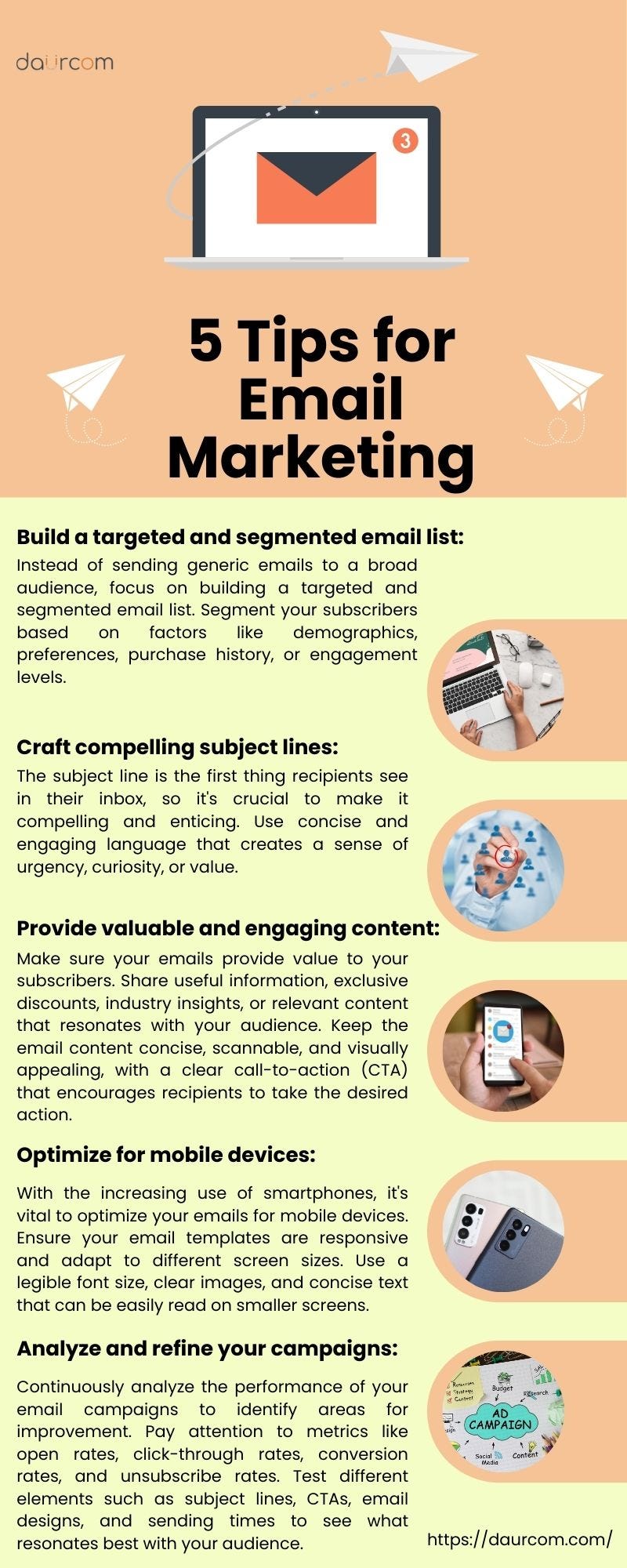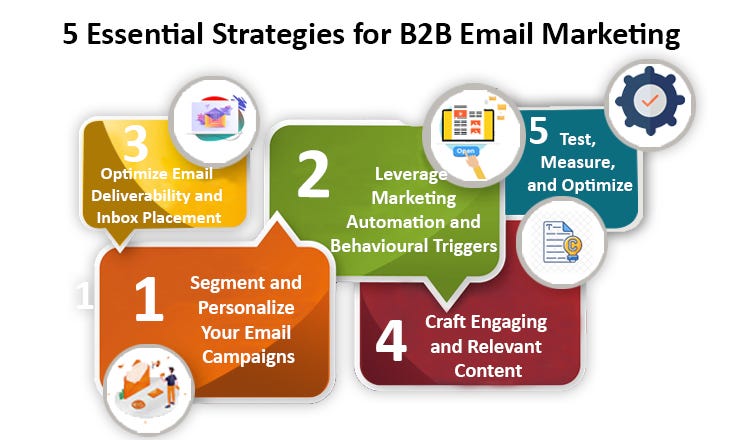Did you know that more than half of all internet users check their emails every single day? This surprising fact emphasizes the potential power of email marketing. Mastering this craft allows firms to reach a sizable segment of their target audience, right at the comfort of their screens.
The history of email marketing dates back to the late 1970s. However, it’s only recently that businesses have started to truly understand its value. Along with its significant growth of about 20% year on year, email marketing provides a whopping 3800% return on investment (ROI) on average. Thus, mastering this craft isn’t simply an option but a necessity for effective communication in today’s digital era.
Success in email marketing requires mastering certain practices. These include crafting compelling subject lines, segmenting your audience for more personalization, optimizing your CTA, testing your campaigns before launch, and analyzing results for continuous improvement.

Crafting Precise Emails: An Essential Marketing Strategy
If you are looking to achieve significant results in marketing, one tool that instruments success is undoubtedly Email Marketing. To truly master the craft of email marketing lies in understanding its best practices. This is not about drafting an email and simply sending it to your subscribers. It involves the art of crafting compelling email content, designing emails for all types of screens, analyzing the results, and continually fine-tuning your strategy.
Creating Compelling Email Content
Email recipients open emails based on the subject line, therefore, it must cater to their curiosity, offering value or addressing a need. Use action-oriented verbiage and personalize where possible. Recipients should know immediately why they need to open your email.
The body content should then deliver what the subject line has promised. Maintain a high value-to-pitch ratio by offering insightful information, advice, or entertainment before trying to sell anything. Maintain relevance by segmenting your audience for more specific content and addressing each recipient by name.
In your email body, keep sentences and paragraphs short for better readability. Feature one main call-to-action (CTA), but present it in various places for higher conversion rates. Use buttons for your CTAs instead of hyperlinks for better mobile optimization.
Avoid heavy use of images as they might not display in many email providers and could come across as spam. Make sure your emails reflect your brand image in the use of images, colors, fonts, language, and tone.
Designing for All Screens
In the current era, emails are no longer accessed solely from desktop computers. People are increasingly checking their emails on mobile phones or tablets. Therefore, the design of your email needs to be optimized for all screen sizes. Making your emails responsive ensures that your subscribers can have the best viewing experience regardless of their device or screen size.
A responsive email layout is flexible and automatically adjusts to the screen on which it is viewed. This means the email is as easy to read on a mobile phone as it is on a desktop. You can achieve this by using a single column layout, large fonts, and buttons that are easy to click on a small screen, and ensuring that all parts of the email, including headers, footers, and menus, fit on a small screen.
In addition to responsive design, take into consideration the platform on which your email will be viewed. Different email clients render HTML differently. Therefore, it’s essential to do your due diligence by testing how your email appears across different clients and platforms before you send it out.
Leveraging Data via Email Analytics
No successful email marketing campaign can be complete without analyzing performance data. This phase involves determining whether the email met its goals, understanding subscriber behavior from the data, and getting insights into how to improve future campaigns.
Analyzing Email Performance
Measuring the success of an email campaign goes beyond open rates. You also need to consider click-through rates, which tell you how many people clicked on the links in your email, and conversion rates, which involve the number of people who took your desired action after clicking a link.
An essential metric is the return on investment (ROI), which compares the money made from the campaign to the cost of running it. To calculate this, track not only the immediate sales from a campaign but also the lifetime value of a customer acquired through the campaign.
Bounce rates can tell you if you have issues with your subscriber list or your campaign content. A high bounce rate may mean that you are trying to send emails to non-existent addresses, or your email content is being flagged as spam.
Lastly, pay attention to engagement and retention metrics, such as email sharing or forwarding rates, and unsubscribe rates. These can provide insights on your audience’s perception of your email content.
Effectively Using Insights for Future Campaigns
Information gained from analytics should guide your future strategy. For example, frequent unsubscriptions after a particular type of email may indicate that your audience finds it unattractive or irrelevant. Or if a specific type of email led to a considerable number of conversions, you would want to replicate these elements in the future.
Analytics can also help you generate more personalized content. If a segment of your audience repeatedly interacts with content related to a specific topic, you can optimize all future emails to these subscribers with related content and product recommendations.
Use A/B testing to try out different versions of an email to see which one performs better. Experiment with different subject lines, email content, sending times, and even email designs to find the most effective formula for your email marketing.
Mastering the craft of email marketing involves an all-encompassing understanding and effective practice of each of these elements. It’s not a talent one is born with, but a continuous learning curve that adjusts with the changing landscapes of digital marketing practices and consumer behaviors. With these best practices at your fingertips, you are now equipped to create more effective and engaging email marketing campaigns.
How to Master Email Marketing (2024)
Tips for Excelling in Email Marketing
Email marketing, when executed properly, can yield significant results for businesses. To achieve success, it’s crucial to abide by some best practices.
1. Personalize your messages: Instead of sending generic emails, personalize your messages to each recipient to increase engagement rates.
2. Make use of automation: Use email marketing tools to send automated messages based on users’ behaviors or preferences.
3. Write compelling subject lines: A strong subject line grabs your audience’s attention and encourages them to open and read your message.
4. Include a clear call-to-action: Direct your readers to take the desired action, whether it’s making a purchase, downloading a resource, or simply visiting your website.
5. Test and optimize: Use A/B testing to identify which strategies work best for your target audience and continuously optimize your efforts.

Frequently Asked Questions
In the ever-evolving world of digital marketing, email remains one of the most effective channels for engaging customers and driving conversions. Here are some commonly asked questions about mastering the craft best practices for email marketing.
1. Why is segmentation important in email marketing?
Segmentation is the practice of dividing your email list into distinct groups based on characteristics like demographics, behavioral data, and purchase history. It allows you to send personalized and relevant content to each segment, which can result in higher open and click-through rates. Subscribers appreciate emails that are tailored to their preferences and needs.
Without segmentation, your emails risk falling into the generic “one-size-fits-all” category, which often leads to lower engagement rates. Mastering segmentation can contribute significantly to the success of your email marketing strategy.
2. How can I prevent my emails from landing in the spam folder?
Deliverability is a key concern in email marketing. Your beautifully crafted and personalized emails are of no use if they end up in the spam folder. There are several things you can do to prevent this. First, make sure you’re adhering to all email marketing laws and regulations, which include obtaining explicit permission from recipients before sending them emails and always offering a way to unsubscribe.
Second, maintain a clean email list by regularly removing inactive subscribers. High bounce rates can affect your email deliverability. Finally, provide valuable and relevant content. This will not only engage your subscribers but also establish your reputation with email service providers as a trustworthy sender.
3. How do I create enticing email subject lines?
Your email’s subject line is the first thing recipients see. If it’s not compelling, they might not even open your email, let alone engage with your content. Some practices mail marketers swear by include keeping the subject line short and sweet, personalizing it by including the recipient’s name, and making it action-oriented to inspire curiosity and urgency.
Moreover, A/B testing your subject lines can give valuable insight into what works and what doesn’t with your audience. Remember, a superb subject line can significantly boost your open rates.
4. What is the best frequency for sending marketing emails?
Striking the right balance in email frequency can be tricky – send too few, and your subscribers might forget you; send too many, and you risk annoying them. The appropriate frequency depends on various factors including your industry, the type of content you send, and your audience’s preferences.
As a general rule, you should monitor your email metrics to determine the ideal number of emails to send. If you notice a spike in unsubscribe or complaint rates when you ramp up your email frequency, you might want to cut back. It’s all about testing, learning, and adjusting your strategy accordingly.
5. What role does email marketing play in building customer relationships?
Email marketing is a great tool for building and nurturing customer relationships. It allows you to maintain regular contact with your customers, provide them with valuable content, and make them feel valued. Strategic use of personalized content like birthday emails, special offers based on past purchases, and helpful tips related to your products can deepen your connection with customers.
Furthermore, by integrating your email marketing with other channels such as social media and your website, you can provide a cohesive and consistent brand experience for your customers. This can lead to increased trust and loyalty, cementing these relationships.
How to Craft the Perfect Email Marketing Strategy
Mastering the craft of email marketing entails deliberate practice and consistent evaluation. It’s about knowing your audience, crafting compelling content, and making every email count. Testing and analyzing the results is also key to improving your approach and ultimately, achieving your goals.
With every email sent, a golden opportunity to connect with customers emerges. A well-constructed email can enhance customer loyalty while driving sales. Keep your emails concise, relevant, and engaging, embrace personalization, and never stop testing for better results. This is the pathway to truly mastering email marketing.